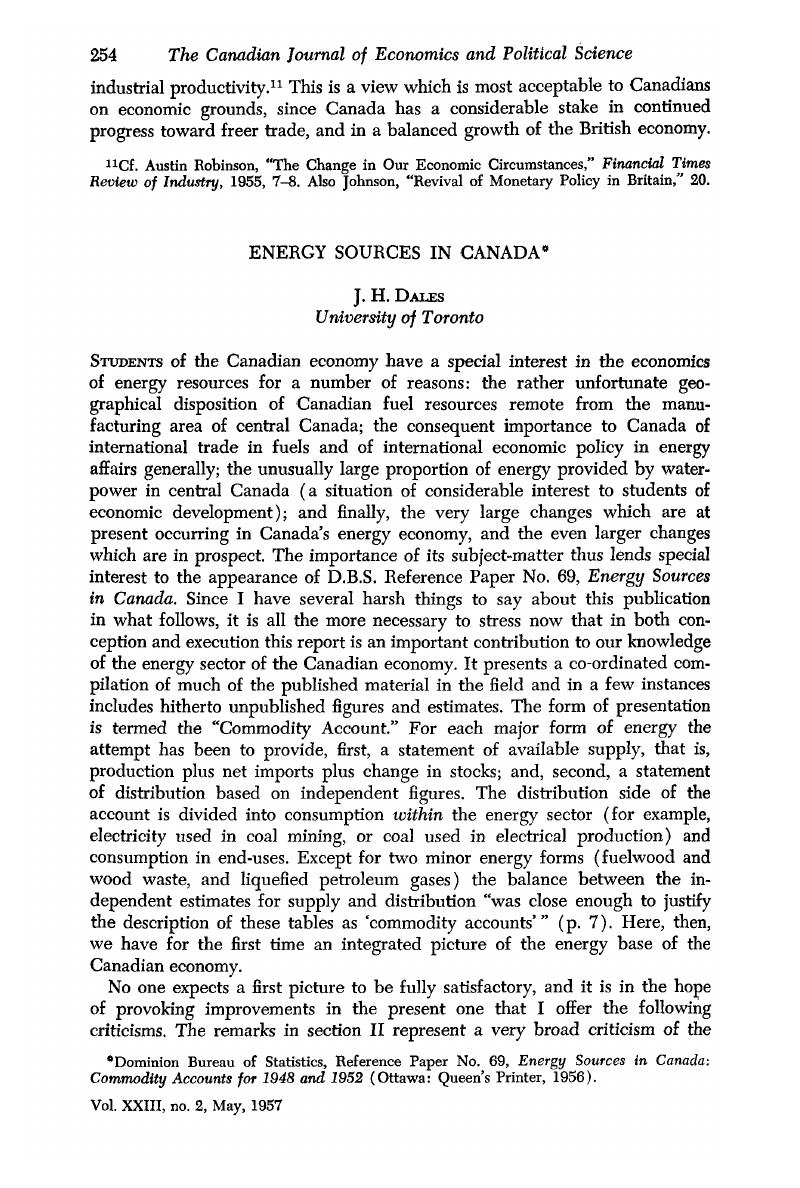No CrossRef data available.
Article contents
Energy Sources in Canada*
Published online by Cambridge University Press: 07 November 2014
Abstract

- Type
- Notes and Memoranda
- Information
- Canadian Journal of Economics and Political Science/Revue canadienne de economiques et science politique , Volume 23 , Issue 2 , May 1957 , pp. 254 - 260
- Copyright
- Copyright © Canadian Political Science Association 1957
Footnotes
Dominion Bureau of Statistics, Reference Paper No. 69, Energy Sources in Canada: Commodity Accounts for 1948 and 1952 (Ottawa: Queen's Printer, 1956).
References
1 Table 7 is entitled “Apparent Available Supply and Measured Portion of Distribution of Fuel and Electricity in Canada, 1948,” but, curiously, the Table makes no mention of available supply. The only supply-side item in Table 5 that has been put into percentage form in Table 7 is “Net Imports.”
2 Bank of Canada, Statistical Summary, 08, 1952, 130.Google Scholar See also Report of the Royal Commission on Coal, 1946 (Ottawa, 1947), 655.Google Scholar
3 More precisely, this was the equivalent used for primary electricity. Secondary electricity, a small part of the total, was properly converted at the heat-producing equivalent of 3.4 million B.t.u.'s per 1,000 k.w.h.'s. On this see n. 6.
4 Instances where electricity is used to produce heat will be mentioned below. For a good statement of the relation between coal and electricity, see Report of the Royal Commission on Coal, 1946, 377–94.
5 This statement is an oversimplification. The problem of an appropriate conversion factor is perhaps most acute when equating electricity and a fuel, but it also arises in equating different fuels. Fuel oil and coal do not pose much difficulty since they are both used for heating purposes. Gasoline and coal give more difficulty since coal is not used in internal combustion engines. We could value a gallon of gasoline at the number of B.t.u.'s it can produce, or at the number of B.t.u.'s in the coal that would be required to produce a gallon of gasoline. The latter valuation is obviously artificial because in fact it is at present uneconomic to produce gasohne from coal. (It would, however, be a reasonable valuation if part of our gasoline supplies had to be made from coal.) The former valuation has not much to recommend it since gasoline is seldom used to produce heat; but it has some indirect rationale in that gasoline and Diesel fuels may be competitive for internal combustion engines while Diesel fuels and coal may be competitive for heat-raising purposes.
6 “Secondary” or “boiler” electricity is used to raise steam in electric boilers. This is a “dump” market, however, and secondary electricity is only sold when central stations have surplus generating capacity. During the depression of the 1930's, when generating capacity was greatly in excess of firm power demand, secondary sales were an important fraction of total sales, especially in Quebec and Ontario, but at present secondary power sales are small, reflecting for the most part seasonal reductions in firm power demand or seasonal excesses of water supply. Secondary electricity is simply a substitute for coal—most of it is, in fact, used in the pulp and paper industry for steam-raising purposes—and therefore this is the one instance where it should be equated to coal at its heat-producing equivalent of 3.4 billion B.t.u.'s per 1,000 k.w.h.'s.
7 Industrial lighting cannot be distinguished from existing statistics either; it would be desirable, if practicable, to separate it from the old “Power and Light” category.
8 The report makes much of the fact that we do not know what proportion of the electricity produced by industrial concerns for their own use is produced from fuels, and the technical concern with the double counting which results from this situation led someone to get the Census of Industry to revise its 1955 questionnaire to provide the required information. That is all to the good, but the matter probably concerns something of the order of 2–3 per cent of electrical production. If questionnaires can be revised to deal with this relatively small matter surely an effort could be made to provide a more adequate break-down of electricity consumption.




